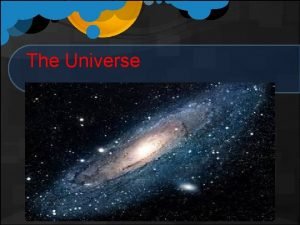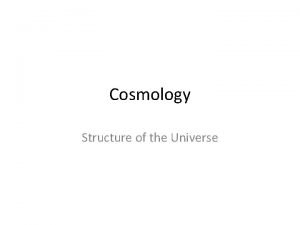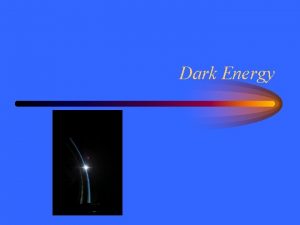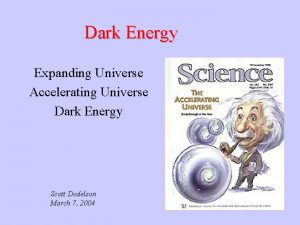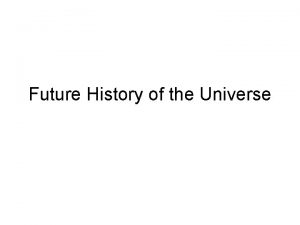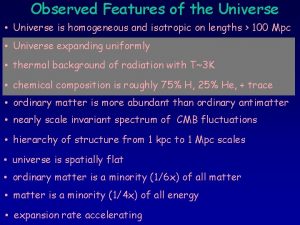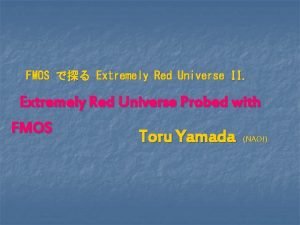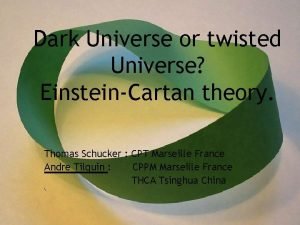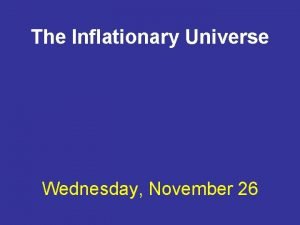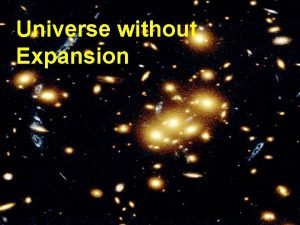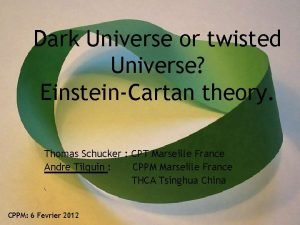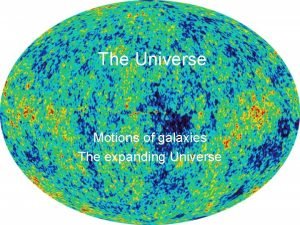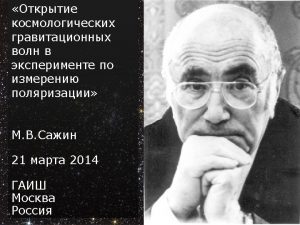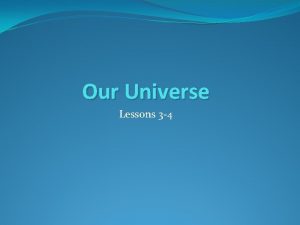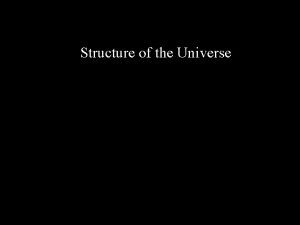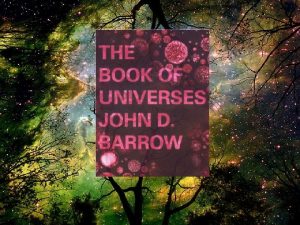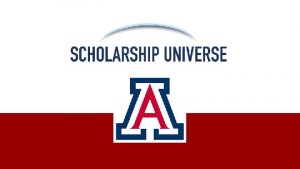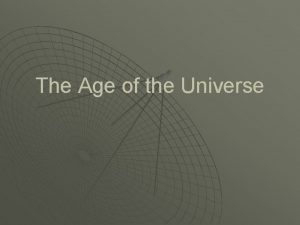1 A The Universe 1 2 3 Only




































- Slides: 36

1

A. The Universe 1. 2. 3. Only one exists Composed of space and 100 billion galaxies A galaxy is a grouping of millions or billions of stars kept together by gravity 2

How did the universe begin? u The current understanding of the how the universe began is described by the Big Bang Theory—it wasn’t big and there wasn’t a bang! http: //science. howstuffworks. com/dictionary/astronomy-terms/big-bangtheory 1. htm

Formation of the Universe Big Bang Theory: Explains how universe developed from very tiny, dense “singularity” u

More on the Big Bang Theory The theory states: the universe began from an initial point (or singularity) which has expanded over billions of years to form the universe as we now know it today.

Formation of the Universe u Big Bang Theory: According to BBT, UNIVERSE is 13. 7 Billion years old

Formation of the Universe Big Bang Theory: Does NOT explain what initiated creation of universe – Only describes expansion of universe u

4. Edwin Hubble (in 1929) proposed that the Universe is expanding a. This is supported by a phenomenon called the Doppler shift 1). Stars are moving away from Earth and their light becomes dimmer. This is called the red shift. This gives support of the expanding universe 2). If stars move toward Earth, we see a blue shift – light becomes brighter 8

Putting it Together… u Inversely Proportional: • Wavelength increases = Frequency decreases

Universe is EXPANDING u Doppler Effect: – Change in frequency of waves moving relative to its source • • • Stars moving AWAY = RED shift Stars moving TOWARD = BLUE shift Greater the shift = faster the speed

11

Universe is EXPANDING Evidences? u • Cosmic Background Radiation – Low temp waves indicating explosion occurred • Gravity – Responsible for movement of dust clouds to form planets and stars

13

14

15

B. Galaxies 1. 2. Galaxies are classified according to their shape Spiral galaxies often appear bluish because they contain many young stars a. Young stars give off blue light when they burn 3. Elliptical galaxies often appear reddish because they contain many old stars a. Old stars give off red light when they burn 16

Galaxies, cont. 4. 5. A large cluster of galaxies is called a supercluster Our solar system is inside the galaxy known as the Milky Way a. The Milky Way is classified as a spiral galaxy 6. The Milky Way contains interstellar matter that may form new stars 17

Elliptical 18

Spiral Galaxies 19

Milky Way Galaxy Top View Side View 20

C. The Solar System 1. Copernicus (1473 -1543) first proposed that Earth and the other planets orbit the sun 2. The orbits of the planet were first said to be elliptical by Kepler (1571 -1630) 3. The brightest object in our sky (besides the sun and the moon) is Venus 21

Nickolas Copernicus 22

Formation of Solar System u. Nebular Theory: SOLAR SYSTEM formed from huge, rotating cloud disk of dust and gases

5. The most widely accepted model of the formation of the solar system is the nebular model where the solar system condensed out of a nebula – a huge cloud of interstellar gas and dust i. Planets may have formed out of material orbiting the early sun through the process of accretion where small particles collide and stick together to form larger masses ii. Gaseous clouds—nebulae, which slowly rotate, gradually collapse and flatten due to gravity and eventually form stars and planets. Our solar system is approximately 4. 6 billion years old. 24

What is the difference between the Solar System, Galaxy, and Universe? • Basically SIZE is the biggest distinction. – We live on planet Earth which is part of our local Solar System. – Our Solar System includes the Sun and everything that orbits the Sun. – Our Sun, is just one Star in the Milky Way Galaxy. – The Milky Way Galaxy is just one Galaxy in the Universe.

KEPLER • HELIOCENTRIC MODEL • 3 LAWS OF PLANETARY MOTION

Kepler’s First Law • Orbit of every planet is an ellipse with Sun at one foci (focus)

Kepler’s Second Law u. Planet moves fastest when closest to Sun and slowest when farthest from Sun u. Equal areas are swept out in equal amount of time

Kepler’s Third Law • Compares distance of each planet from Sun and its orbital period around Sun

www. pavilion. co. uk The order of the planets are Mercury, Venus, Earth, Mars, and Jupiter, Saturn, Uranus, and Neptune. 30

What’s the Difference? • SIZE and COMPSITION

Terrestrial Planets • Inner 4 Planets: – Mercury – Venus – Earth – Mars – Small, solid, rocky surfaces

Jovian Planets • Outer 4 Planets: – Jupiter – Saturn – Uranus – Neptune – Larger, gaseous, and lacks solid surfaces

34 www. universetoday. com

Earth Facts • Distance to Sun: ~92, 000 Million miles • Age of Earth: ~4. 6 Billion Years • Size: 5 th largest in solar system

i. Mercury is closest to the sun and has very hot temperatures ii. The inner planets and outer planets are separated by an asteroid belt iii. The great red spot on Jupiter is believed to be a giant storm iv. All of the gaseous outer planets have rings 36
 Leave only footprints take only photos
Leave only footprints take only photos Từ ngữ thể hiện lòng nhân hậu
Từ ngữ thể hiện lòng nhân hậu Trời xanh đây là của chúng ta thể thơ
Trời xanh đây là của chúng ta thể thơ Tư thế ngồi viết
Tư thế ngồi viết Thế nào là giọng cùng tên?
Thế nào là giọng cùng tên? Gấu đi như thế nào
Gấu đi như thế nào Thể thơ truyền thống
Thể thơ truyền thống Hổ sinh sản vào mùa nào
Hổ sinh sản vào mùa nào Diễn thế sinh thái là
Diễn thế sinh thái là đại từ thay thế
đại từ thay thế Thế nào là hệ số cao nhất
Thế nào là hệ số cao nhất Vẽ hình chiếu vuông góc của vật thể sau
Vẽ hình chiếu vuông góc của vật thể sau Frameset trong html5
Frameset trong html5 Thế nào là mạng điện lắp đặt kiểu nổi
Thế nào là mạng điện lắp đặt kiểu nổi Mật thư anh em như thể tay chân
Mật thư anh em như thể tay chân Lời thề hippocrates
Lời thề hippocrates Vẽ hình chiếu đứng bằng cạnh của vật thể
Vẽ hình chiếu đứng bằng cạnh của vật thể Tư thế worms-breton
Tư thế worms-breton Quá trình desamine hóa có thể tạo ra
Quá trình desamine hóa có thể tạo ra Khi nào hổ con có thể sống độc lập
Khi nào hổ con có thể sống độc lập Các châu lục và đại dương trên thế giới
Các châu lục và đại dương trên thế giới Dạng đột biến một nhiễm là
Dạng đột biến một nhiễm là điện thế nghỉ
điện thế nghỉ Bổ thể
Bổ thể Biện pháp chống mỏi cơ
Biện pháp chống mỏi cơ độ dài liên kết
độ dài liên kết Phép trừ bù
Phép trừ bù Thiếu nhi thế giới liên hoan
Thiếu nhi thế giới liên hoan Tia chieu sa te
Tia chieu sa te Bài hát chúa yêu trần thế alleluia
Bài hát chúa yêu trần thế alleluia Một số thể thơ truyền thống
Một số thể thơ truyền thống Sơ đồ cơ thể người
Sơ đồ cơ thể người Công thức tính độ biến thiên đông lượng
Công thức tính độ biến thiên đông lượng Số nguyên tố là gì
Số nguyên tố là gì Tỉ lệ cơ thể trẻ em
Tỉ lệ cơ thể trẻ em đặc điểm cơ thể của người tối cổ
đặc điểm cơ thể của người tối cổ Các châu lục và đại dương trên thế giới
Các châu lục và đại dương trên thế giới





































